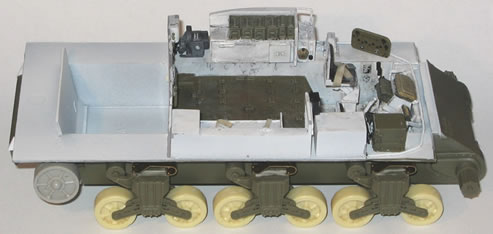The Hull Interior
This
conversion requires that you perform some fairly significant surgery on the AFV
Club lower hull, and, naturally, this should be done before decking out the interior.
Four millimeters need to be removed from the outer edges of the sponsons, as well
as one millimeter from the front and rear edges. Other stubs and placement points
on the floor and sponsons must be carved away and smoothed with some sandpaper. Once
that's done it's good to install the final drive housing and the rear plate, then
see how well the resin upper hull fits in place. This is where I noticed the shrinkage
problem with the TWS part, particularly where the glacis meets the housing. Later
it would take some pressure applied while using the superglue and a bit of Testors
contour putty to bridge the small gap. Hull
InteriorThe
M36B1 hull interior stitches together features of the M4A3 (primarily in the front
and the rear bulkhead) and the combat compartment for the tank destroyer, which
required a different configuration for ammo stowage. My references had gaps in
coverage or contradictions between them. The instructions from TWS do not specify
the exact placement of parts, so you need to eyeball them. Make sure you dry fit
everything several times. I used the placement of the rear wall as my guide and
positioned parts as they led to the front of the vehicle. For
me, this interior is the best feature of the TWS set, though not without its glitches.
A couple parts were AWOL from the kit, but Jay got those to me quickly. My box
came with a pair of extra dividers; one seemed to be ID'd in the instructions,
but not the other. After consulting my spotty references and a couple emails back
and forth with Jay, it turned out they were from a different kit. The
TWS kit doesn't provide 100% of what you need inside, but close. I added straps
for the ammo bin, seat belts, and some wiring for the front.
The AFV Club decal set provides an assortment of equipment labels, but mainly
for the turret interior. I used a number of markings from the more extensive sheet
from Fingerprint Designs. I just wish they could be seen better once in
place! But I like knowing they are there. Introduction
Hull
Interior
Hull
Exterior
Turret
Finishing | 











